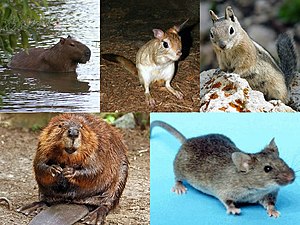Rodent
| Rodents Temporal range: 56–0 Ma Late Paleocene–Holocene |
|
|---|---|
 |
|
| Clockwise from top left: capybara, springhare, golden-mantled ground squirrel, house mouse and beaver representing the suborders Hystricomorpha, Anomaluromorpha, Sciuromorpha, Myomorpha, and Castorimorpha, respectively. | |
| Scientific classification | |
| Kingdom: | Animalia |
| Phylum: | Chordata |
| Class: | Mammalia |
| (unranked): | Glires |
| Order: |
Rodentia Bowdich, 1821 |
| Suborders | |
|
Anomaluromorpha |
|
 |
|
| Combined range of all rodent species (not including introduced populations) | |
Anomaluromorpha
Castorimorpha
Hystricomorpha (inc. Caviomorpha)
Myomorpha
Sciuromorpha
Rodents (from Latin rodere, "to gnaw") are mammals of the order Rodentia, which are characterized by a single pair of continuously growing incisors in each of the upper and lower jaws. About 40% of all mammal species are rodents; they are found in vast numbers on all continents except Antarctica. They are the most diversified mammalian order and live in a variety of terrestrial habitats, including human-made environments.
Species can be arboreal, fossorial (burrowing), or semiaquatic. Well-known rodents include mice, rats, squirrels, prairie dogs, porcupines, beavers, guinea pigs, hamsters, and capybaras. Other animals such as rabbits, hares, and pikas, whose incisors also grow continually, were once included with them, but are now considered to be in a separate order, the Lagomorpha. Nonetheless, Rodentia and Lagomorpha are sister groups, sharing a most recent common ancestor and forming the clade of Glires.
...
Wikipedia
